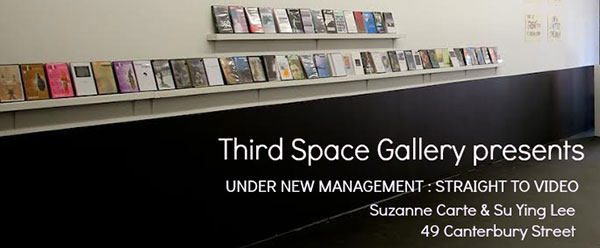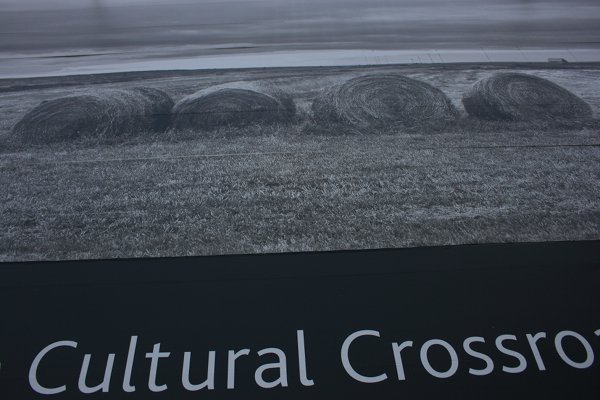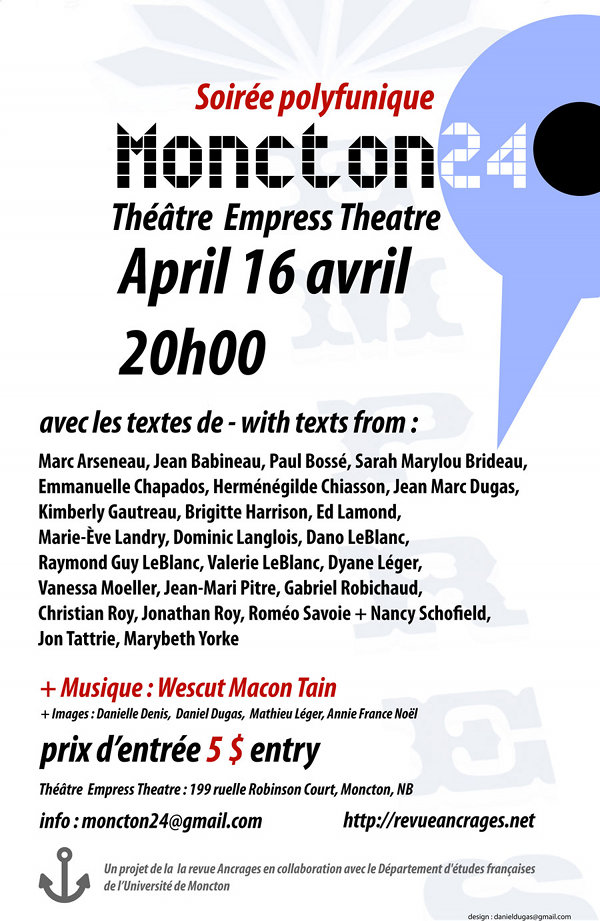No 26 – Entre ciel et mer. Rencontre Est-Ouest
Deux de mes textes « Canapé » et « Sero » font partie du numéro 26 Entre ciel et mer. Rencontre Est-Ouest, un projet collaboratif entre la revue Ancrages (NB) et la revue À ciel ouvert (SK).
Écrire en français, que ce soit dans l’Ouest ou dans l’Est du pays, c’est avant tout un acte de résistance contre la marée montante de la culture anglo-américaine dominante. La langue française doit avoir, pour se développer, des occasions d’être exprimée publiquement, d’être entendue et, dans ce cas présent, d’être lue.
Extrait du liminaire de Jean-Pierre Caissie
L’instinct de respirer
Gisèle Villeneuve. Bone loss / Artiste Jean-Sébastien Gauthier
Rachel Bonbon. I et II / Artiste Lou-Ann Bourdeau
Joëlle Préfontaine. Manifeste : J’parle mal pis j’aime ça / Artiste David Champagne
Marika Drolet-Ferguson. lien de sens / Artiste Estelle Bonetto
Martine L. Jacquot. Tu viens à moi / Artiste Zoé Zénon
L’horizon des possibilités
Robert Malo. Bulles nocturnes / Artiste Guillaume Lépine
Daniel H. Dugas. Canapé suivi de Sero / Artiste Maryse Arsenault
David Baudemont. Plaines aquarelles / Artiste David Baudemont
Joanie Serré. Le binaire / Artiste Mario Rhéal Landry
Alasdair Rees. Trois mois, trois tois / Artiste Michèle Mackasey
Josée Thibault. Mon arbre (La fille du facteur) / Artiste Denis Lanteigne
Paul Ruban. Jan Van Zanten / Artiste Frédéric Gayer
Caroline Bélisle. Van Gogh / Artiste Anne-Marie Sirois
Au-delà des contours et des souvenirs
Mikhu Paul. Pow-wowland du vingtième siècle / Artiste Emily Sanipass
Louise Dandeneau. Crucifix / Artiste Léopold L. Foulem
Laurent Poliquin. Ô toi souveraine souvenance / Artiste Sylvie Pilotte
Simon Brown. Basse-Croisière / Artiste Laura St. Pierre
Crédits et remerciements
Numéro conjoint des revues Ancrages et À ciel ouvert
Édition : Jean-Pierre Caissie et Marie-Diane Clarke
Commissariat en arts visuels : Anne Brochu-Lambert et Jean-Pierre Caissie
D’après une idée originale de Jean-Pierre Caissie et Sébastien Rock
Coordination du numéro : Rachel Duperreault et Jeffrey Klassen
Édition et révision : Georgette LeBlanc
Couverture : Frédéric Gayer
Œuvre de couverture : Lou-Anne Bourdeau, ciel mer, aquarelle et encre sur papier, 2018.
Mise en page du numéro pdf : Jean-Pierre Picard
Mise en ligne du numéro web : Jean-Pierre Caissie
Comité de rédaction d’Ancrages : Sonya Malaborza, Georgette LeBlanc, David Décarie, Marc Chamberlain, Jean-Pierre Caissie, Paul Bossé, Joël Boilard.
Comité de rédaction de la revue À ciel ouvert : Jeffrey Klassen, Sébastien Rock, Marie-Diane Clarke, Henri Biahé, David Baudemont, Jean-Pierre Picard
ISSN 1712-9281
La revue acadienne de création littéraire Ancrages tient à souligner la contribution financière du Conseil des arts du Canada, du gouvernement du Nouveau-Brunswick et de la Ville de Moncton à la réalisation de ses activités. Nous en sommes reconnaissant.e.s.
Under New Management – Saint John (2014)
Under New Management : Straight to Video
Curated by Suzanne Carte and Su-Ying Lee
January 18, 2014 – February 28, 2014
Reception & Talk with Curators: February 15th, 4:30 to 6:30
Third Space Gallery – 49 Canterbury Street
Frankly, we’re not your typical video store. Far from it! In fact, Under New Management is a virtual entertainment funhouse allowing you to pay-what-you-wish. We have many rare titles and a unique rental policy!
Under New Management: Video Store exhibition takes the form of a video rental store that carries artists’ videos. The project employs the characteristics of the retail environment to connect to the local community while, challenging the gallery’s role as an intermediary that delimits the viewer’s direct access to art. Video titles in stock are artists’ works procured through an open call for submissions. “Customers” are asked to pay what they wish, which can be interpreted as cash, a non-monetary exchange, critique, or no remuneration. This facet is in place as an experimental form of engagement, where artists have the opportunity to receive responses directly from viewers. In turn, the viewer has an uncommon channel to the artist. In addition to payment, rental and return are also on an honour-system basis to remove barriers that exist due to membership requirements, deposits, and return policies at commercial ventures.
Boundaries are blurred and expectations subverted through a presentation model that proposes a hybrid between the gallery context and the broader public sphere. Currently, we are on the cusp of the dematerialization of the video rental business. Large corporate chains and family run businesses share in the same fate. The most unfortunate loss is that of the local independent operation that carried rare titles, cult favorites, documentaries, experimental films, and hard to find foreign titles. Under New Management: Video Store provides audiences with the opportunity to view content that is not produced strictly by Hollywood with blockbuster aspirations.
All good things must come to an end. Unfortunately the trend of vanishing family-owned establishments is not just affecting the mom & pop shops that conveniently distribute videos and stale popcorn, but even the bigger institutions fall. Honest Ed’s is on the chopping block to be sold to the highest real estate bidder. In wake of this current news, Lena Suksi’s bright hand-painted video store signage too will soon become a nostalgic part of our recent past.
Our dvd collection boasts over 200 titles including a cross-section of documentaries, experimental, drama, science fiction, comedy, and horror. We also have a growing collection of VHS tapes! Don’t miss out. Rent today!
You will find works by Alleyway A.G., Jose Angeles, Alleyway A.G. (Dr. Oliver Love), Artlitwell, Bambitchell, Perry Bard, Aleks Bartosik, Steve Basham, Sarah Beck, Ashley Bedet, Simon Belleau, Stephane Boutet, Theodore Boutet, Pierre Chaumont, Millie Chen, Emelie Chhangur, Michèle Pearson Clarke, collectif_fact, Eva Colmers, Claro Cosco, Department of Biological Flow, Sarah DiPaola, Robert Dayton, Zoran Dragelj, Daniel Dugas, Megan Dyck, Caz Egelie, Clint Enns, Sky Fairchild-Waller, Fake Injury Party, Simon Frank, Lisa Folkerson, Magill Foote, Barbara Fornssler, Sarah Fortais, Kandis Freisen, Stephen Paul Fulton, Daniel Gallay, Paul Gordon, Shlomi Greenspan, Keeley Haftner, Martin Hamblen, Ursula Handleigh, Sienna Hanshaw, Mike Hansen, Paul Harrison, Mathew Hayes, Stefan Herda, Karen Hibbard, Candice Irwin, Shawn Olin Jordan, Felix Kalmenson, A.S.M Kobayashi, Eva Kolcze, Apostoly Peter Kouroumalis, Lamathailde, Toni Latour, Anastasia Lognova, Christopher Lacroix, Valerie LeBlanc, Renee Lear, Julie Lequin, Melanie Lowe, Duncan MacDonald, Logan MacDonald, Adrienne Marcus Raja, Mani Mazinani, Penny McCann, Arlin McFarlane, Francis Adair KcKenzie, Kristine Mifsud, Gordon Monahan, Caroline Monnet, Didier Morelli, Lydia Moyer, John Monteith, Grey Muldoon, Midi Onodera, Juan Ortiz-Apuy, Ryan Park, Jason Penney, Sarah Pupo, Jai Arun Ravine, Richard Reeves, Iqrar Rizvi, Nicki Rolls, Kuk Del Rosario, Jade Rude, Lyla Rye, Matthieu Sabourin, Nathan Saliwonchyk, Juli Saragoas, Liana Schmidt, Melinda Seville, Olivia Simpson, Tom Smith, Barbara Sternberg, Leslie Supnet, Maya Suess, Laura Taler, Aislinn Thomas, Peter Von Tiesenhausen, Carolyn Tripp, Carmen Victor, vsvsvs, Ellen Wetmore, Elinor Whidden, Paul Wiersbinski, James Brendan Williams, Oauk Wiersbinski, Damien Worth, Robert Zverina… and many more!
Under New Management is comprised of the curatorial team Suzanne Carte and Su-Ying Lee, a collective of cultural producers working in contemporary art. Operating as a mutable entity, UNM re-invents roles and shifts boundaries to inspire production and engagement. Collaboration with new and experimental strategies is at the forefront of their practice.
Suzanne Carte is an independent curator and critical art writer. Currently, she works as the Assistant Curator at the Art Gallery of York University (AGYU) focusing on an integrative model to utilize public programming as a pedagogical tool within the academic institution. Previously she held positions as outreach programmer for the Blackwood Gallery and the Art Gallery of Mississauga and as professional development and public program coordinator at the Ontario Association of Art Galleries. She is on the Board of Directors of C Magazine, an international art quarterly devoted to promoting critical discussion about contemporary art. Within Suzanne’s independent practice, she has curated exhibitions in public spaces, artist-run centres, commercial and public art galleries including All Systems Go!, Under New Management, MOTEL and Man’s Ruin. Suzanne recently completed her Masters of Contemporary Art at the Sotheby’s Art Institute in New York City.
Su-Ying Lee recently completed a one-year curatorial residency at the Justina M.Barnicke Gallery, funded by the Canada Council for the Arts. Lee has both institutional experience and a number of independent projects to her credit. She has curated exhibitions that include the work of Kent Monkman and Lawrence Weiner and commissioned the work of Harrell Fletcher and Wendy Red Star. Her curatorial practice has been steadily evolving into the expanded field. Lee is interested in the role of curator as co-conspirator, accomplice and active agent. She seeks new ways to mobilize art, audiences and context.
Une Chance (2012)
Ce texte a été écrit dans le cadre des consultations publiques du Renouvellement de la politique culturelle 2012 au Nouveau-Brunswick.
————————————————————————————————————————————–
Un artiste ne peut attendre aucune aide de ses pairs.
Jean Cocteau
Les artistes sont les juges compétents de l’art, il est vrai, mais ces juges compétents sont presque toujours corrompus. Un excellent critique serait un artiste qui aurait beaucoup de science et de goût, sans préjugés et sans envie. Cela est difficile à trouver.
Voltaire
Si ces deux citations évoquent un certain malaise, la situation actuelle de l’artiste et de l’art pourrait être beaucoup plus sérieuse qu’on ne le pense. Les arts, quoiqu’on en dise, ne sont pas nécessaires à la survie de l’humanité. Ils sont peut-être indispensables à la survie de certains individus, j’en conviens et j’en suis un pour qui l’importance de l’art est essentielle, mais l’humanité est très peuplée. On se rappellera que les arts et la créativité se trouvent au sommet de la fameuse pyramide des besoins d’Abraham Maslow [1], si le sommet est une position enviable, la vue y est très belle, c’est malheureusement la représentation du besoin le moins pressant à combler. L’art semble être au-dessus, mais se trouve derrière les besoins d’appartenance, les besoins de sécurité du corps et de l’emploi, derrière les besoins physiologiques; manger, boire, dormir, respirer. Cette affirmation peut sembler cruelle, surtout pour les artistes qui persistent à créer contre vents et marées, mais elle reflète une cruelle vérité.
La beauté de la chose et la difficulté de la chose, c’est que les artistes feront ce qu’ils ou elles pensent devoir faire. On parle de vocations, de penchant impérieux qu’un individu ressent pour une profession. Quoi qu’on en dise, un artiste n’est pas comme un agent d’assurances, un analyste financier, un anthropologue, un anesthésiste réanimateur, un archéologue, un avocat, un cardiologue, un charcutier, un chef cuisinier, un concierge, un conseiller en toxicomanie, un démographe, un dentiste, un dynamiteur, un directeur du marketing, un économiste, un électricien, un facteur, un géologue, un historien de l’art, un infirmier, un ingénieur minier, un journaliste, un linguiste, un mathématicien, un négociateur en bourse, un pharmacien, un sapeur, un technicien en construction aéronautique, un téléphoniste, un traducteur ou un zoologiste. L’artiste est le seul qui soit prêt à faire son devoir sans rémunération. Personne d’autre n’est prêt à commettre une telle bêtise, aucune autre profession n’offre ça.
Il n’y a pas si longtemps un artiste qui exposait son travail dans une galerie s’attendait à recevoir un cachet CARFAC pour sa participation [2]. Ce temps est révolu, et ce même s’il y a une campagne publicitaire qui circule sur la toile et qui trompette : Je suis un artiste, ça ne veut pas dire que je travaille gratuitement. La fanfare perd un peu d’ardeur lorsqu’on réalise qu’en octobre 2011 la campagne de réélection de Barack Obama lançait un appel d’offres invitant des graphistes à faire don de leurs dessins pour une affiche [3]. Il y a de plus en plus d’artistes qui sortent des écoles d’art, toujours plus nombreuses, de plus en plus de demandes de bourses, d’expositions, de plus en plus d’effervescence. Ce bouillonnement d’activités coïncide avec l’émergence d’une nouvelle sensibilité de partage; on n’a qu’à penser aux conditions de réutilisation ou de distribution d’œuvres, établies par Creative Commons [4] ou encore le phénomène de l’externalisation ouverte (crowdsourcing) [5] . Dans le fond tout ça c’est excellent, le problème c’est que les administrations ne vont pas toujours au même rythme que les administrés. Comment rationaliser, comprendre d’une manière cohérente et logique la dynamique de développement d’un centre d’artiste autogéré qui reçoit plus de 200 demandes par année alors qu’il n’offre que 3 expositions ! Quelles sont les possibilités qui s’offrent aux artistes émergents ou encore à ceux et celles qui réémergent ? Nous vivons dans une société de concurrence et les arts font face à la même musique, à la même folie. La réalité, c’est qu’un artiste est maintenant heureux, bienheureux de participer à un événement, de faire partie d’une exposition, et ce même s’il n’y a pas de cachet, car on le sait maintenant, l’invisibilité tue.
Que peut-on faire devant une telle réalité ? Investir plus d’argent dans les arts ? Sûrement, c’est une solution, mais là n’est l’objet de mon intervention. Ce que j’aimerais suggérer ici, ce n’est pas une augmentation des budgets, c’est l’introduction d’un élément de flexibilité, de spontanéité dans le lourd appareil bureaucratique de l’administration des arts. Pour ceux et celles qui ont participé à un jury ou pour les agents des Conseils des Arts, il est évident que ce n’est pas toutes les bonnes demandes qui reçoivent des bourses. Il est toujours malheureux, en fait déchirant, de voir des projets de très grandes qualités tomber dans l’oubli et la négation. La solution que je propose est la suivante : que les Conseils des Arts réservent un pourcentage du budget total d’un jury, d’une compétition ou d’un programme, disons par exemple de 5 % d’un budget de 140,000 $ (7,000 $) et qu’ils procèdent à un tirage au sort avec les demandes qui se sont distinguées, mais qui n’auraient pas reçu de bourse. Cette façon de procéder ne réglerait pas tous les problèmes qui existent, mais donnerait la chance à quelqu’un qui n’en aurait pas eu. Cette chance me semble être quelque chose d’essentiel. Cocteau et Voltaire l’ont bien remarqué. Si les artistes ne peuvent pas toujours compter sur leurs pairs pour les aider, le hasard pourrait s’en charger.
Daniel Dugas
Moncton, 26 septembre 2012
Daniel Dugas porte plusieurs chapeaux, une calotte de poète, un bonnet de vidéaste, une casquette de musicien et un feutre de graphiste. Son travail est visible à www.daniel.basicbruegel.com
[1] Site officiel de Abraham Maslow: http://www.maslow.com/
Wikipédia Abraham Maslow: http://fr.wikipedia.org/wiki/Abraham_Maslow
[2] CARFAC: http://www.carfac.ca/
[3] Rolling Stone Magazine, TIM DICKINSON, Obama Solicits Designers to Work – Unpaid – on … Jobs Poster! http://www.rollingstone.com/politics/blogs/national-affairs/obama-solicits-designers-to-work-unpaid-on-jobs-poster-20111019
Voir, Art Works a poster contest to support American Jobs : https://my.barackobama.com/page/s/artworks-submission
Voir, Design for Obama: http://designforobama.org
[4] Creative Commons: http://creativecommons.org/
[5] Externalisation ouverte : Pratique qui consiste pour une organisation à externaliser une activité, par l’entremise d’un site Web, en faisant appel à la créativité, à l’intelligence et au savoir-faire de la communauté des internautes, pour créer du contenu, développer une idée, résoudre un problème ou réaliser un projet innovant, et ce, à moindre coût. Office québécois de la langue française, 2010
Lancement Moncton24 (2012)
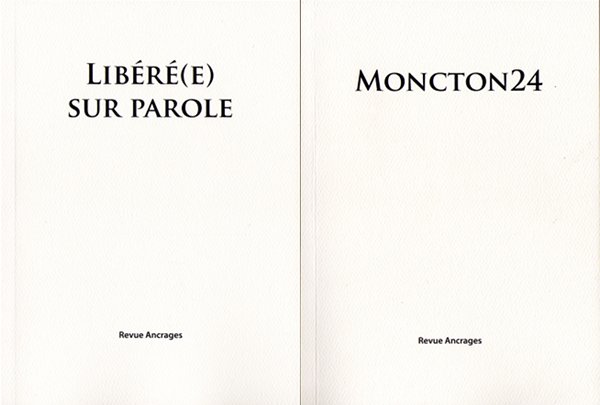
La revue Ancrages a le plaisir de vous convier au lancement de son numéro spécial : LIBÉRÉ (E) SUR PAROLE et MONCTON24. Le lancement aura lieu le 4 août à la Boulangerie Grain de Folie, à Caraquet, à partir de 15 h 30 ! Le numéro sera également lancé à Moncton en septembre.
[mise en contexte|
LE 13 MARS 2010, le premier volet de Moncton24 s’est déroulé sous un soleil étincelant et sous une lune splendide.
Moncton24 a été conçu comme un projet d’écriture à plusieurs voix, un projet polyfunique, qui visait à saisir l’esprit d’une ville ou la substance d’un espace : celui, à la fois matériel et symbolique, que nous habitons, qui nous habite. Cet événement littéraire a regroupé 24 auteures et auteurs de langue française et anglaise qui se sont approprié un endroit de la ville et un temps de la journée (ou de la nuit) et ont écrit un texte sur cet espace et ce moment particulier. 24 auteurs en 24 heures pour recréer, sur un autre plan, la ville que nous habitons.
La contrainte des 24 heures a une longue histoire. Elle correspond à une journée dans la vie, à une « révolution de soleil », comme l’a écrit Aristote en parlant de la règle des trois unités du théâtre classique. Déjà en 1923, on inaugurait les 24 heures du Mans, la célèbre course automobile d’endurance, où des équipes de pilotes se relayaient jour et nuit sur une piste de 13,000 km. Plusieurs d’entre nous se rappellent peut-être de la série de grands livres illustrés The Day in the Life, qui a débuté en 1981 et où des photographes professionnels tentaient de saisir, en 24 heures, l’essence du coin de pays qui leur avait été assigné. On pourrait aussi rappeler les 24 heures de poésie de Sousse en Tunisie ou encore l’événement slam des 24 heures du mot de Liège.
Moncton 24 s’insère dans cette grande tradition où la mesure du temps encadre l’action des participants et quels moments merveilleux nous avons eu la chance de vivre ! Que ce soit dans un parc ou dans un café, Moncton s’est animée pour devenir un lieu magique de création littéraire.
Les photos de la journée d ‘écriture et de la soirée polyfunique sont disponibles sur flickr.com et sur google map sous la rubrique Moncton24
Sackville vs Pleasantville vs Ibiza (2010)
Style & Artifacts is a series of articles about the cultural symbolism of artifacts and monuments in landscapes and cityscapes. Black and white welcome signs, an outdoor sculpture that gets wrapped in winter, as well as bizarre swastikas patterns integrated into architecture are some of the topics that will be examined. The articles will be posted in episodes.
Editing assistance: Valerie LeBlanc
Sackville vs Pleasantville vs Ibiza
Sackville wanted to set itself apart from other towns by using black and white in their advertisements.[13] Well-done Sackville! I have to agree that the new signs contrast with others. One example being the colorful sign on Highway 15 near Moncton, that depicts two amazingly happy kids at a water park.
To present Sackville as a black and white destination may unintentionally have alluded to the movie Pleasantville. [14] You have to agree that Sackville and Pleasantville have a similar ring to them. This allegorical movie presents two universes; one in black and white, where old fashion values reign, and a modern one in full color. The protagonists go back and forth between the worlds and eventually the quaint little town changes its ways to become colorful. Are the utopias of Sackville and Pleasantville related? Should we, the tourists and the lonely truck drivers on the highway, be called in by the billboards? Should we emulate Bud and Mary Sue Parker in the Pleasantville movie by going into the black and white town, “to educate (the town) about issues such as personal freedoms, styles of art, and literature? ”[15]
Katie Tower of the Sackville Tribune wrote a critical article about the billboards: Does Town’s new highway sign say Sackville? [16] In it, she pointed out that the billboards were not ‘really saying much about the vibrant cultural scene that makes up this quaint university town known as Sackville”.[17] Tower is right about the vibrancy of the cultural scene but I don’t think the billboards are off target either. This town has not been misrepresented because this town is a quaint little place. Let face it Sackville is not Ibiza, the number one party town in the world.[18] It is true that Sackville has an impressive scope of activity for its size. In 2008, it was even named a Cultural Capital of Canada, [19] succeeding the town of Wendake, Quebec. But Sackville is above all quaint, meaning that it has an old-fashioned charm, that it is unusual in an interesting and pleasing way. The fact that it was selected by the Canadian Association of Retired Persons as one of the best places to live in Canada, [20] speaks volume about its pace. It is traditional and quiet, it is pastoral and the sign says it well.
But then if you look at the photograph a bit longer you can see all those little antennas, hidden by the speed of travel. Could this be a metaphor for the hidden wildness that can be found there? People say that every little town has its secrets. If it is true then maybe this is the real subtlety of the new identity campaign. It managed to evoke the most secret trait of its population without them realizing it. Perhaps beneath the tranquil exterior of idyllic, almost arcadian life, there is a wild heart beating. Maybe like a mullet, Sackville is all ‘business in the front and party in the back.’ That thought would be subject matter for further research.
Daniel Dugas,
Moncton, August – October 2010
[13] “Everything is in colour these days. Everybody wants to use colour and use the same thing to attract people to their community…but we don’t want to look like the other towns.” Graham Watt, member of Sackville Tourism Advisory Committee.Visitors will be welcomed to Sackville with unique image. Tower, K. (2009, May 6). Sackville Tribune Post.
[14] IMBd The Internet Movie Database
[15] Pleasantville (film). (2010, July 21). In Wikipedia, the free encyclopedia. Retrieved August 9, 2010, from http://en.wikipedia.org/wiki/Pleasantville_(film)
[16] Does towns new highway sign say Sackville?. Tower, K. (2009, June 17). Sackville Tribune Post.
[17] idem
[18] Best Party Cities in the World, Retrieved October 15, 2010, from: http://www.virgin-vacations.com/11-top-party-cities.aspx
[19] 2008 Cultural Capitals of Canada, Retrieved September 1st, 2010, from http://www.pch.gc.ca/pgm/ccc/ccc08-eng.cfm
[20] Sackville Arts Walk brochure – Feb. 2010
Nice town, y’know what I mean? (2010)
Style & Artifacts is a series of articles about the cultural symbolism of artifacts and monuments in landscapes and cityscapes. Black and white welcome signs, an outdoor sculpture that gets wrapped in winter, as well as bizarre swastikas patterns integrated into architecture are some of the topics that will be examined. The articles will be posted in episodes.
Editing assistance: Valerie LeBlanc
PART 1
Nice town, y’know what I mean?
Last year the town of Sackville, in an attempt to bring more people to town[1], installed two black and white billboards on the Trans-Canada highway. The team of marketing specialists believed that the use of a black and white image would create enough of a shock to achieve this goal. This æsthetic action created waves within the community. There were a few newspaper articles and letters to the editor written; some praising the audacity of the signs, and some others were more critical. After a year, I was curious to see how the marketing dust was settling in the ever-windy Tantramar Marsh.
Traveling in a northwesterly direction toward Sackville, I stopped on the side of the road in front of one of the billboards. I had seen the image[2] before, on a previous voyage, but this time I wanted to confront the bucolic scene at a different speed. I got out of the car to stand directly in front of the landscape image. It was huge. The four hay bales lying in a field was even bigger than I thought. The composition of the photograph was centered and balanced. The muted tones and the realism depicted spoke of time-honored tradition and conservatism. The blowup of the image had something of The Gleaners, an oil painting by Millet (1857), but without the peasants.
Looking at the photograph, I was reminded of the famous line by the Stage Manager, the narrator of the play Our Town[3] written by Thornton Wilder in 1937: Nice town, y’know what I mean? There was something warm and safe about it, even if was wrapped in the coldness of the black and white. Under the picture is a slogan stating that Sackville is the Cultural Crossroads of the Maritimes.
Marsh and Mirror
Trucks were traveling down the highway at ferocious speeds raising trails of dust behind them. I was taking pictures of the picture when I realized something both interesting and puzzling at the same time. The billboard image is a mirror of its surroundings. This, by itself, is interesting, after all mirrors are important tools of discovery. Montaigne spoke of the world “as a mirror where we must see ourselves in order to know ourselves,” [4] and Rabelais in a more sarcastic manner reminded us that “If you wish to avoid seeing a fool you must first break the mirror.” [5]
Like a Droste Effect,[6] the image of a marsh within a marsh, could make us question the reasons behind – or beyond the panels. Is the smaller black and white version of the marsh saying something important about the real thing? Is it augmenting or diminishing the existing reality? It is puzzling because there are unfortunately, no answers to inform or transform an understanding of the choice of the image. On that particular day, it looked like a visual hiccup planted on the landscape.
The signage was part of a new strategy to set Sackville apart from other communities. The Tourism Committee hoped that the distinctiveness of the image, ‘its art like qualities’ [7] would be so attractive that it would incite visitors to drive into town. But were there more tourists coming in? In answer to my inquiries, Rebekah Cant – Sackville’s Director of Tourism, offered to set up a meeting with two members from the Tourism Advisory Committee; Councilor Virgil Hammock[8] as well as idea manGraham Watt, who once worked as an advertising man on Madison Avenue. According to them, the billboards have been successful. People have been talking, some positively and yes, others negatively about the signs. If we believe that ‘There’s no such thing as bad publicity…’ [9] like Brendan Behan said, then this daring black and white coup might just work out!
Crossroads and Tollbooths
Marketing strategies are plans of actions and the slogan Sackville, the Cultural Crossroads of the Maritimes is part of the new identity promoted by the highway signs. But what is this Cultural Crossroad business? What does it mean? Like some people in Sackville that I spoke to, I thought it was a printing error. Was it supposed to read Agricultural Crossroads? After all, hay bales strongly point to cultivation.
A crossroad is a point of intersection. It is also the point where an important choice has to be made. Am I going straight or am I turning off? If the Trans-Canada Highway and the streets of Sackville are the cultural roads, then what important choice has to be made here? To stop? Maybe, although it might not be extremely important if you don’t need the usual services required by travelers. Does this great intersection of roads warrant our attention? Is there a traffic light where we will have to stop, or a tollbooth where we will have to toss a coin?
How can Sackville set itself apart from others when a crossroad is exactly about the importance and the dependency of others? Because, let’s not forget that without these ‘others’ there will be no crossroad at all.
Yore and “Ohm sweet Ohm”[10]
But let’s go back to the image: the sky is heavy with clouds, it rained earlier or it will at some point. It feels cold. It is nostalgia wrapped into melancholy. But why hay bales? Why this picture? I know that hay is feed for animals, that there are different qualities of feed and that one hay bale of this variety weights about 1,000 pounds. I know that making hay involves many steps; cutting; drying; processing and storing. But really what does it have to say about the town? Do Sackvillians live in straw houses? Is there a museum of Hay Fever? Can I buy a hay-bale-key-chain or a hay-bale-pen at the gas station?
But wait a minute, just above the bales, the sky is lighting up, or as Thornton Wilder wrote at the very beginning of his play ‘… Sky is beginnin’ to show some streaks of lights over the East there…’ [11] Yes! Now I see, parsed in the glimmer, a series of little sticks planted in the ground. These sticks are the antennas of the famous Radio Canada International transmitter station.[12] RCI has been located in the Tantramar Marshes since the early 40’s and it broadcasts a multilingual schedule of shortwave programs throughout the world. Could these high frequencies emitted from this colony of towers represent the cultural roads of Sackville? I don’t know but I could almost hear something…
The antennas in the background could actually be the clue that unlocks this marketing campaign mystery, but they are so small and so delicately drawn onto the landscape that they might not be seen at all. I doubt that the restless kid, in the backseat of the average minivan traveling at highway speeds, will notice them and start yelling to his parents: “MOM! DAD! ANTENNAS! ANTENNAS! CAN WE STOP AT THE RADIO CANADA INTERNATIONAL STATION PLEASE! PLEASE! PLEASE! CAN WE?”
End of part 1.
Tomorrow – the conclusion: Sackville vs Pleasantville vs Ibiza
[1] Tower, K. (2010, May 6). Visitors will be welcomed to Sackville with unique image. “In an effort to set itself apart from other communities, Sackville is taking a unique approach to drawing in visitors off the highway” Sackville Tribune Post.
[2] The photograph is part of the Radio Canada International portfolio created by renowned photographer Thaddeus Holownia during a 28-year period (1977-2006).
[3] Our Town. (2010, July 26). In Wikipedia, the free encyclopedia. Retrieved August 9, 2010, from http://en.wikipedia.org/wiki/Our_Town
[4] Michel De Montaigne quotes. Think exist – Finding Quotations was never this Easy!. Retrieved September 4, 2010 from http://thinkexist.com/quotation/traveling-through-the-world-produces-a-marvelous/347128.html
[5] François Rabelais quotes. Brainy Quote Retrieved September 4, 2010 from http://www.brainyquote.com/quotes/quotes/f/francoisra176266.html
[6] Droste effect. (2010, August 2). In Wikipedia, the free encyclopedia. Retrieved August 9, 2010, from http://en.wikipedia.org/wiki/Droste_effect
[7] Tower, K. (2010, May 6). Visitors will be welcomed to Sackville with unique image. Sackville Tribune Post.
[9] Strangely enough, we really acknowledge the latter part of the phrase: There’s no such thing as bad publicity except your own obituary. The Phrase Finder. Retrieved September, 1st, 2010, from http://www.phrases.org.uk/meanings/there-is-no-such-thing-as-bad-publicity.html
[10] “Ohm sweet Ohm” is a song on Radio-Activity a 1975 concept album around simulated radiowave and shortwave sounds by Kraftwerk. Radio-Activity. (2010, July 24). In Wikipedia, the free encyclopedia. Retrieved August 9, 2010, from http://en.wikipedia.org/wiki/Radioactivity_(album)
[11]“The first act shows a day in our town. The date is May 7, 1901, just before dawn. (COCK CROW off stage.) Aya, just about. Sky is beginnin’ to show some streaks of lights over the East there…..” Our town: a play in three acts By Thornton Wilder, from Google Books. Act 1, page 2.
[12] Radio Canada International. (2010, May 10)). In Wikipedia, the free encyclopedia. Retrieved August 9, 2010, from http://en.wikipedia.org/wiki/Radio_Canada_International
GO TO PART 2 : Sackville vs Pleasantville vs Ibiza
MONCTON 24 – Soirée polyfunique (2010)
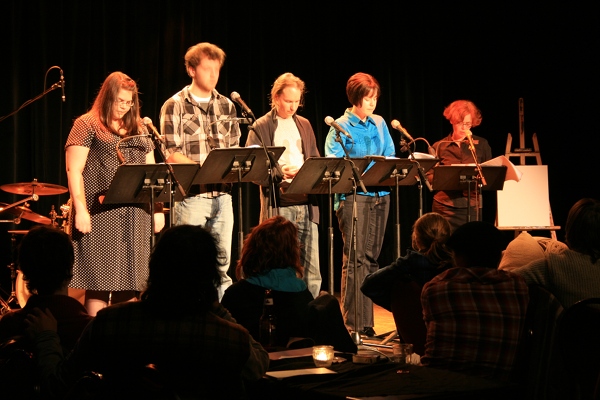 [Marie Éve Landry, Gabriel Robichaud, Dominic Langlois, Mary-Beth Yorke, Valerie LeBlanc]
[Marie Éve Landry, Gabriel Robichaud, Dominic Langlois, Mary-Beth Yorke, Valerie LeBlanc]
La Soirée polyfunique a été un grand succès! Les photos sont sur Flickr!
MONCTON 24 – Une journée dans la vie littéraire de Moncton (2010)
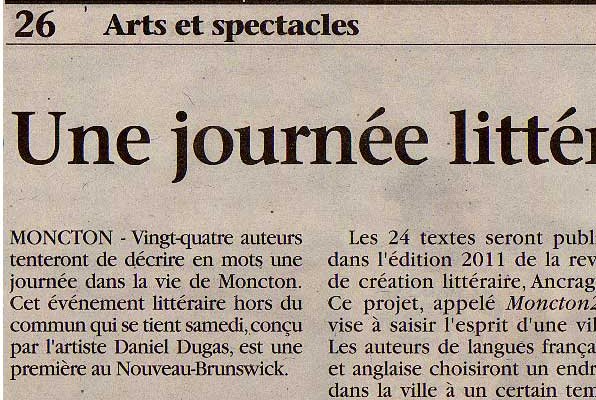
Un article par Sylvie Mousseau de L’Acadie Nouvelle paru le 12 mars 2010.
haute résolution: Voir Internet Archive
MONCTON 24 – Poster ! (2010)
Voici le poster pour la Soirée Polyfunique du 16 avril 2010!
Soirée Polyfunique Moncton24
Le premier volet de l’événement Moncton24 a eu lieu samedi le 13 mars dernier. Organisé par la revue Ancrages, il a réuni 24 auteures et auteurs de langues française et anglaise qui ont vécu, saisi et écrit une heure et un lieu différents de la ville de Moncton. Durant ces 24 heures, les rôles ont été inversés : de 0h00 à 24h00, c’est la ville qui a habité ses écrivains.
Le vendredi 16 avril 2010, à 20h00, dans la salle Empress du Théâtre Capitol se tiendra la deuxième partie de cet événement littéraire : la Soirée Polyfunique Moncton24, dans laquelle les auteures et les auteurs participeront à la lecture d’un montage textuel de leurs écrits. Il y aura également une projection des photos prises sur les lieux d’écriture et des prestations musicales assurées entre autres par Wescut Macon Tain.
L’entrée de l’Empress est située sur la rue Robinson
Soirée Polyfunique Moncton24
The first segment of the event Moncton24 took place on March 13, 2010. Organized by the journal Ancrages, it brought together 24 French and English authors. The writers stationed themselves in specific places in the city of Moncton for a specific hour to put into words, a sense of being there.
On Friday, April 16, beginning at 8 p.m. the second segment of this literary event will be held at the Empress Room at the Capitol Theatre. During the Soirée Polyfunique Moncton24, the authors will read their texts as part of a montage of the collective works. There will also be projections of images taken at the writing locations, interdispersed with musical performances by Wescut Macon Tain.
The entrance to the Empress is located at 199 Robinson Court.
Daniel H. Dugas
Archives
Blogroll
- A.I.R. Vallauris
- ACAD
- Adobe additional services
- Adobe Creative Cloud
- AIRIE
- Amaas
- Amazon Author Central
- ARTothèque
- Australian Poetry
- Basic Bruegel
- Bitly
- CCCA
- CDBaby
- Cycling 74
- Dissolution
- Éditions Prise de parole
- Emmedia
- eyelevelgallery
- FAVA
- Festival acadien de poésie
- Festival FRYE Festival
- FILE – Electronic Language International Festival
- Freeware list
- Fringe Online
- Galerie Sans Nom
- Gotta Minute Film Festival
- Instants Vidéo
- JUiCYHEADS
- Kindle Direct Publishing
- Klondike Institute of Art and Culture
- La Maison de la poésie de Montréal
- La Maison de la Poésie et de la Langue française Wallonie-Bruxelles
- Laboratorio Arte-Alameda
- Le Centre Jacques Cartier
- Liberated Words
- Maison Internationale de la Poésie – Arthur Haulot
- MediaPackBoard
- Miami Book Fair International
- Monoskop
- Mot Dit
- NSCAD University
- Paved Arts
- PoetryFilm
- Portail des auteurs du Nouveau-Brunswick
- RECF
- Revue Ancrages
- Salon du Livre du Grand Sudbury
- Sculpture Space
- Subtropics.org
- Sydney college for the arts
- The Centre for Contemporary Canadian Art
- The New Gallery
- Trevigliopoesia
- tumbler-documents
- V Tape
- Valerie LeBlanc
- VideoBardo
- Void Network-Κενο Δίκτυο
Categories
- #covidpoèmes
- Advertisement
- AIRIE
- Ancrages
- anthology
- Anthropocene
- Architecture
- Around Osprey
- art
- Article de presse
- arts visuels
- audio
- Australian Poetry
- Basic Bruegel Editions
- Book
- book fair
- Cafe Poet Program
- Ce qu'on emporte avec nous
- Citations gratuites
- Collaboration
- commentaire
- commentary
- Compte rendu
- conférence
- Conservation Foundation of the Gulf Coast
- COVID-19
- Critique littéraire
- culture
- Daniel Dugas
- Design
- Édition Michel-Henri
- Éditions Perce-Neige
- Éloizes
- Emmedia
- emoji etc | émoji etc
- Environnement
- essai
- essay
- Everglades
- Exhibition
- festival
- Festival acadien de poésie
- Festival Frye Festival
- FIPTR
- Flow: Big Waters
- Fundy
- Habitat
- installation
- Instants Vidéo
- interactivity
- journal
- JUiCYHEADS
- Kisii
- L'Esprit du temps
- laptop
- Leaving São Paulo
- lecture
- Livre
- logos
- Magazine
- Miami Book Fair
- Moncton 24
- novel
- OASIS
- oil spill
- perception
- performance
- Photo
- poésie
- Poetic Licence Week
- Poetry
- politics
- politique
- press
- Prise de parole
- Revue Ancrages
- salon du livre
- sculpture
- Sculpture Space
- sound
- Souvenirs
- Spirit of the Time
- Style & Artifacts
- Symposium d'art/nature
- talk
- television
- The New Gallery
- Uncategorized
- Valerie LeBlanc
- vidéo
- vidéopoésie
- Videopoetr/Vidéopoésie
- videopoetry
- visual arts
- What We Take With Us
- youth literature






